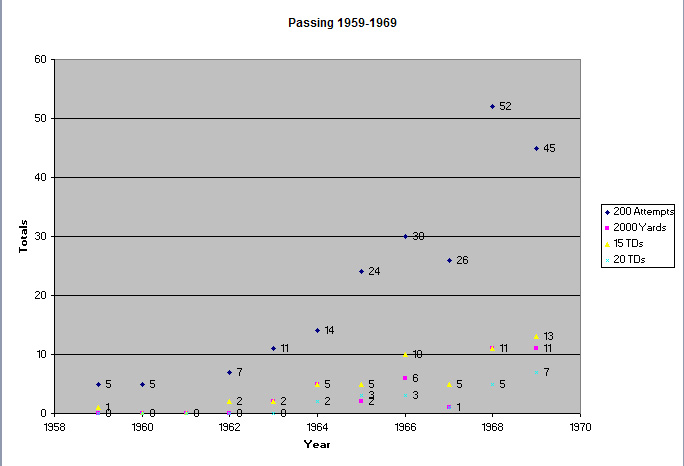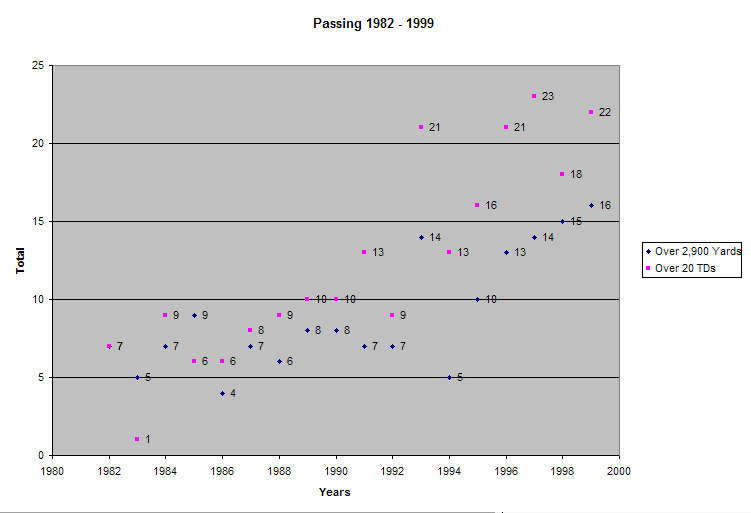When most think of college football, you generally have three segments of thought and recall: The first group thinks of the bygone era featuring Army’s Earl “Red” Blaik from 1941-1958 unleashing players such as Doc Blanchard, Glenn Davis, and Johnny Lujack on opponents. They’ll think of the dominant Oklahoma squad of the 1950’s that set record breaking undefeated seasons. The second group thinks of the 1970s and 1980s with the rise of the Wishbone Offense and the dominance of Option teams like Nebraska, Oklahoma, Notre Dame, and the Pro Style of the Miami Hurricanes. The third group thinks of the gaudy offenses of today such as the Air Raid and the Zone Read Spread and as of late, the proliferation of up-tempo No Huddles.
So let’s trace the evolution of the passing game from the late 1950s to the present day.
1950’s and 1960’s
Nearly every single team in college football at the time of the 1950s ran the ball, period. They lived by the axiom, “Run the Ball and Stop the Run to Win.” Running Backs were also rarely utilized as anything more than just to run the ball, as catching the ball more than once a game was considered extreme. Just take the 1956 Season for example.
Jim Brown (Syracuse): 986 yards and 13 TD rushing but just 5 catches.
Don Clark (Ohio State): 797 yards and 7 TD rushing but 0 catches.
Jim Crawford (Wyoming): 1,104 yards and 12 TD rushing but just 2 catches. He led CFB in rushing that year.
In a lot of ways, Oklahoma’s dominance was a result of challenging the status quo thinking on how to win games offensively. RBs Tommy McDonald and Clendon Thomas both combined to run for 25 TDs but more importantly they combined to catch the ball 24 times in 1956. TCU’s Abe Martin was also having a big impact through RB Jim Swink who ran for just 706 yards (2nd on the team) but made his name by corralling 23 passes for 450 yards. Swink’s number of receiving yards was not only the most among RBs but still would have put him in the Top 100 for rushing yards.
By 1959, signs of the landscape changing was starting to come into focus in two ways: Quarterbacks were being given the chance to throw the ball more and coaches were starting to realize the impact that their weapons could have in the open field.
What follows is an Excel Graph highlighting from 1959-1969 the sharp rise in the passing attack at the collegiate football level. With that said, I need to point out how insane Glenn Dobb’s aerial attack was at Tulsa in the mid 1960’s and how revolutionary it was: 1964 QB Jerry Rhome goes 224/326 for 2,870 yards with 32 TD to 4 INT. Keep in mind that this was an era where entire teams were not throwing the ball 200 times. The following year, Bill Anderson would be 296/502 for 3,464 yards with 30 TD to 14 INT. Further proof that the more things may change, the more they may stay the same in some aspects as well.
It’s easy to see the sharp rise in passing by the late 1960s, partly aided by the rise of the professional AFL which used a more wide open passing attack.
The 1970s and 1980s
It really was not until 1973 with two schools out west that the significance of a good passing attack started to come into sharp relief. Those two schools? San Diego State and Lavell Edwards’ BYU program that was just starting its proto-Air Raid offense.
QB Jesse Freitas completed 65.4% of his passes at San Diego State and threw 21 TD along with his nation leading 2,993 yards. Head Coach Claude Gilbert was, in a lot of ways, running a similar heavy pass focused offense as counterpart Lavell Edwards but was flying more under the radar. QB Gary Sheide at BYU had completed over 60% of his passes while throwing for 2,350 yards and 22 TD to 12 INT.
Jack Murphy over at Toledo was doing interesting things as well, particularly in how he was letting his quarterback (Gene Swick) throw the ball but also run the ball at will too. In 1974, Swick threw for 2,234 yards on 287 passes but also ran the ball 206 times and scored 7 TD. The next season he’d throw for 2,487 yards on 308 passes and run 172 times with 8 TD.
1977 in particular was a bit of a break through year in terms of passing. Colleges began getting more obvious talent at the quarterback position which led to teams showcasing their arms.
– QB Doug Williams (Grambling State): 3,286 yards with 38 TD.
– QB Guy Benjamin (Stanford): 2,521 yards with 19 TD.
– QB Marc Herrman (Purdue): 2,453 yards with 18 TD.
A large reason why the dam burst open in the early 1980s was the credit to Lavell Edwards and his marquee quarterback talent along with John Elway at Stanford proving how effective a great quarterback could be to a college program. 1980 saw Jim McMahon set records that were previously unthinkable: 4,571 yards with 47 TD while John Elway himself had thrown for 2,889 yards and 27 TD.
1981 proceeded to see 5 quarterbacks throw for over 3,300 yards including Tony Eason at Illinois while Dan Marino, following the John Elway model of supreme quarterback talent, threw for 2,876 yards and a mind boggling 37 touchdowns.
In 1983, quarterback Steve Young continued BYU’s unprecedented assault on the passing record books by completing 71% of his passes, throwing over 3,900 yards, and throwing 33 touchdowns.
During the mid to late 1980’s, an unheralded key impact of the importance of the passing game was the University of Miami thanks to their proliferation of NFL Caliber talent at the quarterback position and overall dominance: Bernie Kosar, Vinny Testaverde, and Steve Walsh were perennially among the top of the nation in passing yards during their collegiate seasons. The explosion of pass-heavy systems such as the Run-and-Shoot and Air Raid by the early 1990s and late 1990s saw the aerial game expand even further.
The 1990s and 2000s
In some ways, we are in the heaviest passing era of college football ever, largely thanks to the proliferation of schemes such as the Air Raid along with the more extreme pass focused systems of the Spread offense utilizing 4 and 5 wide sets. As more and more teams transition to up-tempo attacks and No Huddle, expect this number to keep rising.
Credit to AP, ChicagoTribune.com, and ToledoBlade.com




